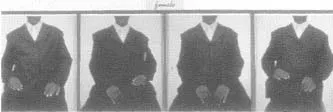
eBook - ePub
Constructing Masculinity
- 350 pages
- English
- ePUB (mobile friendly)
- Available on iOS & Android
eBook - ePub
Constructing Masculinity
About this book
This anthology takes us beyond the status of masculinity itself, questioning society's and the media's normative concepts of the masculine, and considering the extent to which men and women can transcend these stereotypes and prescriptions.
Frequently asked questions
Yes, you can cancel anytime from the Subscription tab in your account settings on the Perlego website. Your subscription will stay active until the end of your current billing period. Learn how to cancel your subscription.
No, books cannot be downloaded as external files, such as PDFs, for use outside of Perlego. However, you can download books within the Perlego app for offline reading on mobile or tablet. Learn more here.
Perlego offers two plans: Essential and Complete
- Essential is ideal for learners and professionals who enjoy exploring a wide range of subjects. Access the Essential Library with 800,000+ trusted titles and best-sellers across business, personal growth, and the humanities. Includes unlimited reading time and Standard Read Aloud voice.
- Complete: Perfect for advanced learners and researchers needing full, unrestricted access. Unlock 1.4M+ books across hundreds of subjects, including academic and specialized titles. The Complete Plan also includes advanced features like Premium Read Aloud and Research Assistant.
We are an online textbook subscription service, where you can get access to an entire online library for less than the price of a single book per month. With over 1 million books across 1000+ topics, we’ve got you covered! Learn more here.
Look out for the read-aloud symbol on your next book to see if you can listen to it. The read-aloud tool reads text aloud for you, highlighting the text as it is being read. You can pause it, speed it up and slow it down. Learn more here.
Yes! You can use the Perlego app on both iOS or Android devices to read anytime, anywhere — even offline. Perfect for commutes or when you’re on the go.
Please note we cannot support devices running on iOS 13 and Android 7 or earlier. Learn more about using the app.
Please note we cannot support devices running on iOS 13 and Android 7 or earlier. Learn more about using the app.
Yes, you can access Constructing Masculinity by Maurice Berger, Brian Wallis, Simon Watson, Maurice Berger,Brian Wallis,Simon Watson in PDF and/or ePUB format, as well as other popular books in Art & Popular Culture in Art. We have over one million books available in our catalogue for you to explore.
Information
Topic
ArtSubtopic
Popular Culture in ArtMASCULINITY AND THE RULE OF LAW |
four

DERRICK BELL

THE RACE-CHARGED RELATIONSHIP OF BLACK MEN AND BLACK WOMEN
THE CHRONICLE OF THE TWENTY-SEVENTH YEAR SYNDROME

It was not long after the terrible phenomenon of the Amber Cloud, when the nation had been totally preoccupied with saving its upper-class, white, adolescent youth from the devastating effects of Ghetto Disease, that it was discovered that the Amber Cloud had, after all, affected at least one category of the black population: able black women, many of them with excellent positions in government, industry, or the professions. Gathering the data was difficult, but it appeared that each month twenty-seven black women in this socioeconomic group were falling ill without apparent reason, about three months after their twenty-eighth birthday.
The illness itself was bizarre in the extreme. Without any warning, women who had contracted the malady went to sleep and did not wake up. They did not wake up. They did not die nor go into a coma. Their bodies functioned, but at less than 2 percent of normal. Nothing known to medical science could awaken the women, save one natural remedy—time. After four to six weeks, the illness seemed to run its course, the women awakened, and, after a brief recovery period, all their physical functions returned to normal.
That was the good news. The tragedy was that, in a special form of amnesia, the women lost their professional skills and were forced to return to school or otherwise retrain themselves in order to continue their careers. In some cases, this meant several years of work and sacrifice that some of the victims were unable or unwilling to make. After some time, medical researchers were able to delineate more specifically the characteristics of the black women at risk. They had: (1) held at least one degree beyond the bachelor’s and had earned an average of thirty-five thousand dollars per year over the three years prior to their twenty-seventh year; (2) completed their twenty-seventh year of life; and (3) had neither been married to nor entertained a bona fide offer of marriage from a black man.
Women who were or had been married to, or who had received a serious offer of marriage from, a black man, seemed immune to the strange malady. But not sexual activity, or a relationship outside of marriage, or even out-of-wedlock motherhood served to protect the victims. Marriages of convenience did not provide immunity, nor did a sexual preference for other women. Strangely, black women married to white men also contracted the disease. Public health officials called the sickness the “Twenty-Seventh-Year Syndrome,” while the tabloids referred to it, with an editorial snicker, as “Snow White’s Disease.”
For a time, the media followed the story eagerly. But gradually—because there were no fatalities and the victims of the malady were spread across the country—the ailment slipped into the category of illnesses, such as sickle-cell anemia, that strike mainly blacks, and thus are only of passing interest to whites.
The nation’s refusal to make the Ghetto Disease cure available to black young people barred all hope that a national mobilization would be undertaken to find a remedy for the Twenty-Seventh-Year Syndrome. And, as one high-placed government health official explained, there was little interest in searching for a medical remedy when a social remedy was at hand: these women should each find a black man who would offer to marry them. “It was,” he said, “as simple as that.”
But as virtually everyone in the black community knew, the simple remedy was, in fact, extremely difficult. The Twenty-Seventh-Year Syndrome had added a dire dimension to what had long been a cause of deep concern to black leaders and a source of great pain and frustration to able black women. For many years before the strange disease made its appearance, the most successful black women had had a very hard time locating eligible black men with whom to have social relationships that might blossom into love, marriage, and family.
Social scientists have isolated several components of the social problem con-fronting all professional women, but exacerbated for blacks by the fact that the black population includes over one million more women than men, and by the high proportion of black men in prisons and among drug addicts compared with the very few who attend college and graduate school. In addition, those black men who survive, and achieve success comparable to that attained by women professionals, have many more social choices. They may not marry at all, or can marry very young women without advanced degrees or professional skills. Some few of the otherwise eligible men are gay; and much to the chagrin of black women, a goodly number are married to white women.
For all these reasons and more, many of the most talented, successful, and impressive black women remain single or do not marry until well into their thirties. As a result, at the very time when the black community is racking its wits about how to address the problem of teenage black girls becoming pregnant and bearing children by young males unable to support them, many of those black women most qualified to raise the next generation of black children remain unmarried and childless.
The unhappy paradox produces disunity in the black middle-class community, where women tend to condemn the inadequacies of black men, and the men, resentful at being further burdened with society’s faults, lash out at black women as being unsupportive and hard-hearted. With the onset of the Twenty-Seventh-Year Syndrome, this debate intensified, as speakers claiming to represent the interests of men or women demanded that the other “do something.”
Federal health officials, still smarting from the attacks by blacks outraged at the government’s failure to extend the Amber Cloud Cure to black youths, determined to act aggressively on the Twenty-Seventh-Year Syndrome. Lacking funds to search for a cure, they decided, with little or no consultation, to issue compulsory Syndrome Control regulations which would, as they said, “serve as a quasi-cure by making known to the ‘cure carriers’ (black men) the identities of those persons at risk.” In summary, single black women between twenty-four and twenty-seven years of age and deemed vulnerable because of their marital and socioeconomic status were required to register with the government. If they had not established stable marriages with black men by the middle of their twenty-seventh year, the law required broad public disclosure of this fact along with detailed biographical information.

Lorna Simpson, She, 1992.
The populace in general and black people in particular were appalled and angered by the new regulations. The charges of “cruel and heartless” were not much reduced by amendments to the law providing that the records of a woman married to, or in a stable relationship with, someone other than a black man would not be made public. It was pointed out that while the Syndrome was disabling, it struck only twenty-seven women each month, and 324 women each year—a serious matter, to be sure, but hardly justifying subjecting literally thousands of black women to a humiliating public display of their personal lives. Civil liberties lawyers seeking to challenge the constitutionality of the regulations as being in violation of First Amendment rights of privacy were stymied by procedural provisions that rendered it difficult for any woman to gain standing to challenge the rules until after she had been subjected to the compulsory publicity in the regulations.
As it turned out, the first woman whose name was selected in a special drawing to receive the publicity expressed little interest in challenging the regulations. Amy Whitfield, a well-known writer, said the law represented a particularly pernicious form of male chauvinism, one more indignity heaped on black women. Given the legacy of rape and degradation that her sisters had endured down through history, she assumed she should be thankful that a male-dominated society had not designed some still more odious process to harass those women already enduring the frightful knowledge that they might soon become a Twenty-Seventh-Year-Syndrome victim.
Ms. Whitfield explained that marriage was not the sole goal of her life, that she and her educated sisters had made contributions and lived full lives without the need to seek rescue from men who were not interested in them. “I am not opposed to marriage,” she said. “There are men I would have married and men who would have married me—but they have never been the same person.”
“Conjugal convergence,” she went on, “requires more men than are available, particularly for black women, all of whom, owing to the horrors of American racial history, find it difficult to contemplate marrying a white man, while some consider it out of the question. Basically,” she concluded, “if the public disclosure required by the statute serves to spotlight some of the dual burdens of racism and sexism black women carry, the humiliation may be bearable. But at this stage of my life, I am not interested in becoming any man’s damned damsel in distress.”
Most black men agreed. The frustrated anger they felt upon learning that the Twenty-Seventh-Year Syndrome attacked only black women turned to rage when government health officials announced their Syndrome Control regulations. Urged by a group of black ministers to vent their fury in positive ways, black men across the country organized “Together at Last” clubs to raise money for the medical research the government refused to fund, set up “sleep-care” facilities to nurse Syndrome victims, and established scholarships to assist recovered women in regaining their skills.
What black men did not do was rush out and propose to black women simply to save them from contracting the Syndrome. As one young black professional put it, “Black women have suffered enough because we have emulated the society’s sexism. Now, in their time of need, we should not add to their Syndrome-caused despair by patronizing marriage proposals that are little more than romantic vaccinations.”
But the syndrome experience did cause many black men who had—”as one option”—taken black women for granted to begin recognizing them for the remarkable individuals they are: survivors in a tough, hostile world, who have overcome difficult barriers and seek men able to share their success and not be threatened by the strengths without which that success would not have been possible.

The change in black male attitudes was slow, halting, and produced no miracles of sex-role reformation. The syndrome continued to claim its predictable number of victims, and there remained far more black women than eligible black men. But out of tragedy came a new awareness and understanding. And while the “black male versus black female” debate continued, the bitterness disappeared from discussions that looked toward reform and away from recrimination.

“Well, I was wrong,” Geneva began, “and you were right in predicting that I would not like your Chronicle. Despite some camouflage, it just brims with patriarchy and sexism. Sure, the society’s racism is a substantial cause of the shortage of eligible black men. I rather doubt, though, that black women or the race will be much advanced if the only cure for racism’s impact on the black families is male domination of the sort implicit in the so-called cure for the Twenty-Seventh-Year Syndrome.”
I raised both hands in defense against her harsh words. “It was only a dream, Geneva. I’m not personally invested in it. Still, it can serve as a vehicle for discussing the degree to which racism has exacerbated for blacks the always-difficult social relationships between men and women. The focus was narrow: namely, on those black women who, having overcome society’s hurdles, find that their professional achievements present barriers to their hopes for personal happiness through marriage and family.1
“The Chronicle of the Twenty-Seventh-Year Syndrome does not disparage the fact that many, many women, regardless of race, live meaningful and entire-ly happy lives without either marriage or child...
Table of contents
- Cover Page
- Half Title page
- Series page
- Title Page
- Copyright Page
- Contents
- Note on the Series
- Introduction
- One What Is Masculinity
- Two Masculinity and Representation
- Three How Science Defines Men
- Four Masculinity and the Rule of Law
- Five Male Subjectivity and Responsibility
- Contributors
- Bibliography
- Photo Credits
- Index